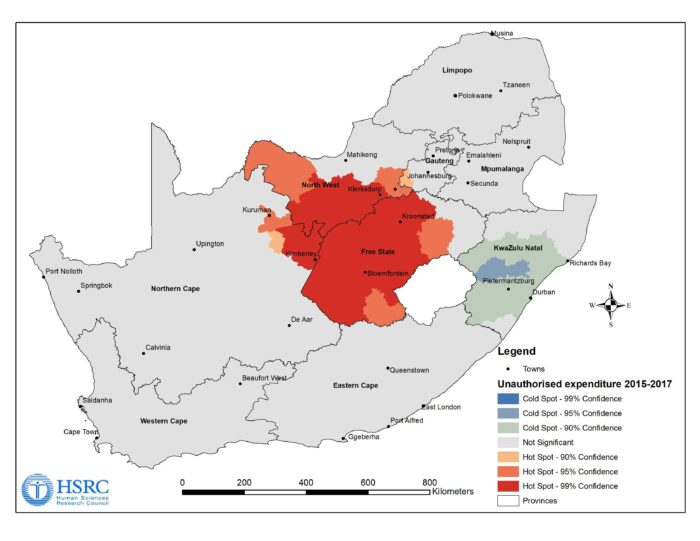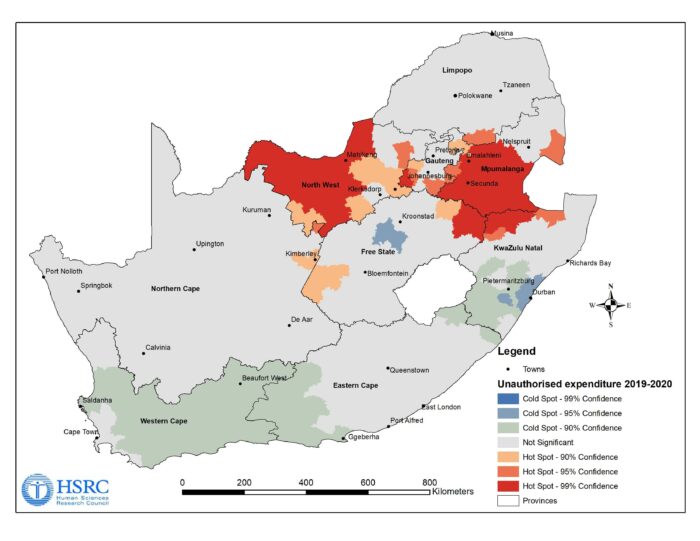
Over the last few years, municipal audits in South Africa have shown irregular expenditure amounting to billions of rands. A recent article by the Geospatial Analytics Unit at the HSRC demonstrated how spatial statistics techniques can be used to indicate hot spots and cold spots, which depict municipal patterns of unauthorised expenditure. This type of mapping and spatial analysis highlights trends and produces information that may inform future predictions or policy and interventions to curb unauthorised expenditure. The techniques could also be applied to other data in the public domain, to demonstrate how key issues affect the country. By Simangele Dlamini and Gina Weir-Smith
In the past decade, municipalities in South Africa have fallen short of using their budgets allocated by National Treasury expeditiously. In the 2018/19 financial year the then auditor-general, Kimi Makwetu, reported that municipal audit results showed an overall regression in auditing outcomes from the previous reporting period. He painted an undesirable picture of billions of rands allocated to municipalities being managed ‘in ways that are contrary to the prescripts and recognised accounting disciplines’.
These administrative and governance lapses, the auditor-general cautioned, made for ease of abuse of the public purse by government officials, which the country can ill afford. The trend continued in the 2020/21 financial year, when levels of unauthorised expenditure remained high, either because municipalities had no plans for some of their developmental projects, or because the estimates made at the beginning of the projects were much lower than actual expenditure incurred. As a result, irregular expenditure increased to R32.06 billion from the R25.2 billion reported in the previous financial year, according to a report by SANews.
Figure 1 illustrates the location of municipalities with the highest unauthorised expenditure in the 2019–2020 Medium-term Expenditure Framework audit period. Overall, 30% of municipalities ended the year with a deficit during this audit period.
Figure 1. Unauthorised expenditure, 2019–2020

What is unauthorised expenditure?
Unauthorised expenditure refers to expenditure incurred by departments that was not spent in accordance with the approved budget. Section 1 of the Public Finance Management Act, 1999 (Act No. 1 of 1999) defines it as ‘overspending of a vote or a main division within a vote’ or expenditure that is made ‘not in accordance with the purpose of a vote’.
A ‘vote’ is the total amount that is usually appropriated per department for use within a certain period, and is approved by the parliament or provincial legislature. Unauthorised expenditure is an indication of noncompliance that needs to be investigated by management to determine whether it was an unintended error, negligence, or done with the intention of working against the requirements of legislation.
Mapping unauthorised expenditure in South Africa
The Geospatial Analytics Unit at the HSRC’s eResearch Knowledge Centre recently published a brief article aiming to illustrate the use of maps in depicting municipal unauthorised expenditure in South Africa. This is against the dire picture presented by the Institute for Security Studies in its 2020 report, Dangerous Elites: Protest, Conflict and the Future of South Africa, which drew a link between the incidence of unauthorised expenditure in municipalities and service delivery protests, a situation exacerbated by high levels of mass unemployment, poverty, and inequality.
Through the use of these maps, specific patterns were identified where there is a concentration of unauthorised expenditure. This pattern analysis uses what is referred to as ‘hot spots’ and ‘cold spots’ analysis. Hot spots are spatial clusters of high values, while cold spots refer to spatial clusters of low values.
The maps showed that between 2015 and 2017 municipal unauthorised expenditure was concentrated (hot spots) around most of the municipalities in the Free State, in the south of North West, and with a few in the north-eastern parts of the Northern Cape province. In total, 21 of the 213 audited municipalities were found to have high levels of unauthorised expenditure (hot spots), while the central parts of KwaZulu-Natal fared much better during this period (cold spots). For the remainder of the municipalities in the country, the audit findings were not adverse or were insignificant in terms of unauthorised expenditure (Figure 2).
Figure 2. Unauthorised expenditure, 2015–2017

Between 2018 and 2019, high levels of municipal unauthorised expenditure (hot spots) were found around municipalities in the east of Limpopo and Mpumalanga, almost all the municipalities in North-West, some to the south and south-west of the Free State, and a few in north-eastern parts of the Northern Cape. Municipalities around the south of KwaZulu-Natal and some in the north-eastern parts of the Eastern Cape fared much better in financial management during this period (cold spots).
Between 2019 and 2020, high levels of unauthorised municipal expenditure were found around most municipalities in North-West and Mpumalanga, with a few in Gauteng. Cold spots (areas with little or no unauthorised expenditure) were found in most of the Western Cape, and in the central and southern parts of KwaZulu-Natal (Figure 3).
Figure 3. Unauthorised expenditure, 2019–2020

The statistical analysis illustrates that municipalities with unauthorised expenditure tend to be concentrated in areas that have been identified in the past as needing administrative intervention in terms of managing their municipal finances, such as North-West, Free State, parts of Mpumalanga, and Limpopo. Incidentally, most of these municipalities are placed in the high-risk category according to the State of Local Government Barometer (2020). In total, 21 municipalities (out of the 213 audited) had statistically significant hot spots between 2015 and 2017. The figure increased to 33 between 2018 and 2019, and decreased to 23 between 2019 and 2020.
In contrast, statistical cold spot municipalities were mostly located in the Western Cape, Eastern Cape and southern parts of KwaZulu-Natal, and the concentration of unauthorised expenditure was not statistically significant in most of the municipalities in the country.
Irregular government expenditure understated, says auditor-general
Despite the irregular expenditure reported between 2015 and 2021, such expenditure remains understated by national and provincial authorities, according to the new auditor-general, Tsakani Maluleke. The reported unauthorised expenditure could be higher, because most of these entities usually do not complete their financial statements in time for audit by the auditor-general’s office, with continued flouting of supply chain laws by departments. “For as long as there are those auditees who can’t give us a confirmation as to the completeness of that number [irregular expenditure], what we must assume is that the number will be higher had they reported it in a way that is credible,” Maluleke asserted. Maluleke added that irregular expenditure could be even higher, as 30% of auditees were qualified because the amount they disclosed was incomplete and/or they had incurred irregular expenditure but the full amount was not known.
The auditor-general noted that there has been an incremental increase in government departments and entities receiving clean audits as a result of improved oversight and leadership commitment to ensuring more efficient financial governance within municipalities.
Authors:
Dr Simangele Dlamini, principal geospatial analyst, and Dr Gina Weir-Smith, head of the Geospatial Analytics Unit in the HSRC’s eResearch Knowledge Centre
